Chicken Fajita Pasta is the ultimate dinner recipe that brings together the bold spices of Tex-Mex cuisine with the creamy comfort of pasta. This dish isn’t just quick and easy—it’s loaded with seasoned chicken, sautéed peppers, and a rich sauce that clings perfectly to every bite of pasta. It’s the kind of meal that satisfies everyone at the table without spending hours in the kitchen.
From its flavorful roots to its modern twists, chicken fajita pasta is more than just a fusion—it’s a weeknight staple with a spicy kick. Whether you’re craving a creamy skillet meal or planning your next meal prep rotation, this guide breaks down everything you need to make it taste just right, every time.
Table of contents
- What Makes Chicken Fajita Pasta a Weeknight Favorite?
- What Culture is Chicken Fajitas From?
- Choosing the Right Pasta for Chicken Fajita Dishes
- How Long Does Fajita Chicken Last in the Fridge?
- Are Chicken Fajitas Actually Healthy?
- How Are Fajitas Traditionally Served?
- Creative Twists on Classic Chicken Fajita Pasta
- How to Master Chicken Fajita Pasta Every Time
- Frequently Asked Questions
- Conclusion
What Makes Chicken Fajita Pasta a Weeknight Favorite?
Chicken fajita pasta with creamy sauce
Chicken fajita pasta hits that perfect balance between flavor-packed and comfort food. The key is in the creamy sauce, which ties together juicy strips of seasoned chicken, sautéed bell peppers, and tender pasta. A mix of chili powder, cumin, paprika, and garlic gives it that signature fajita-style heat, while cream or cream cheese smooths it all out. The sauce doesn’t just coat the pasta—it soaks into it, creating a bite that’s rich, smoky, and satisfying.
A typical skillet recipe comes together in under 30 minutes, making it ideal for busy nights. Add a touch of lime juice or cilantro for brightness, and suddenly you’ve got a dish that tastes like it took much longer. No need for side dishes or extra pots—just one pan and a hungry crowd.
Flavor profile of traditional fajita spices
Fajita seasoning is the heart of this dish. It’s not just heat—it’s a layered blend that brings warmth, depth, and aroma. Paprika adds earthiness, cumin gives it a smoky kick, and chili powder brings mild heat. Onion and garlic powder round things out, and a pinch of oregano gives a Tex-Mex lift.
When these spices are used to season both the chicken and the sauce, they carry a consistent flavor throughout the entire meal. Combined with a hint of acidity from lime or tomatoes, the result is bold without being overpowering. Whether you’re using a homemade mix or a quality store-bought version, the spices elevate a simple pasta into something unforgettable.
Cozy up with this rich and creamy Marry Me Chicken Soup—so good, it just might win hearts!
What Culture is Chicken Fajitas From?
The Tex-Mex roots of chicken fajitas
Chicken fajitas trace their roots back to the ranchlands of South and West Texas. Traditionally made with skirt steak and known as “fajitas” from the Spanish word faja (meaning “strip” or “belt”), this dish started as a humble meal prepared by Mexican ranch workers. The original method involved grilling tough cuts of meat and serving them sizzling hot with peppers and onions on a cast-iron pan.
As fajitas grew in popularity across the U.S., chicken became a widely accepted alternative to beef. By the 1980s, chicken fajitas appeared on restaurant menus across Texas, often served on a hot skillet with warm tortillas, fresh pico de gallo, and guacamole. This mix of Mexican ingredients and Texan cooking methods gave rise to what we now know as Tex-Mex cuisine.
How chicken fajitas evolved into fusion dishes
Over time, chicken fajitas jumped off the skillet and into recipes like wraps, bowls, and pasta. These creative variations took the core fajita flavors—seasoned meat, bell peppers, onions, and bold spices—and blended them with everyday favorites. One of the most popular spins? Chicken fajita pasta.
By combining the classic seasoning with pasta and creamy sauce, home cooks started turning a rustic dish into a fusion that worked perfectly for busy kitchens. It’s now a go-to for weeknight dinners, potlucks, and meal prep alike. The flavor still carries that Tex-Mex punch, but the presentation has evolved into something heartier and more versatile.
Choosing the Right Pasta for Chicken Fajita Dishes
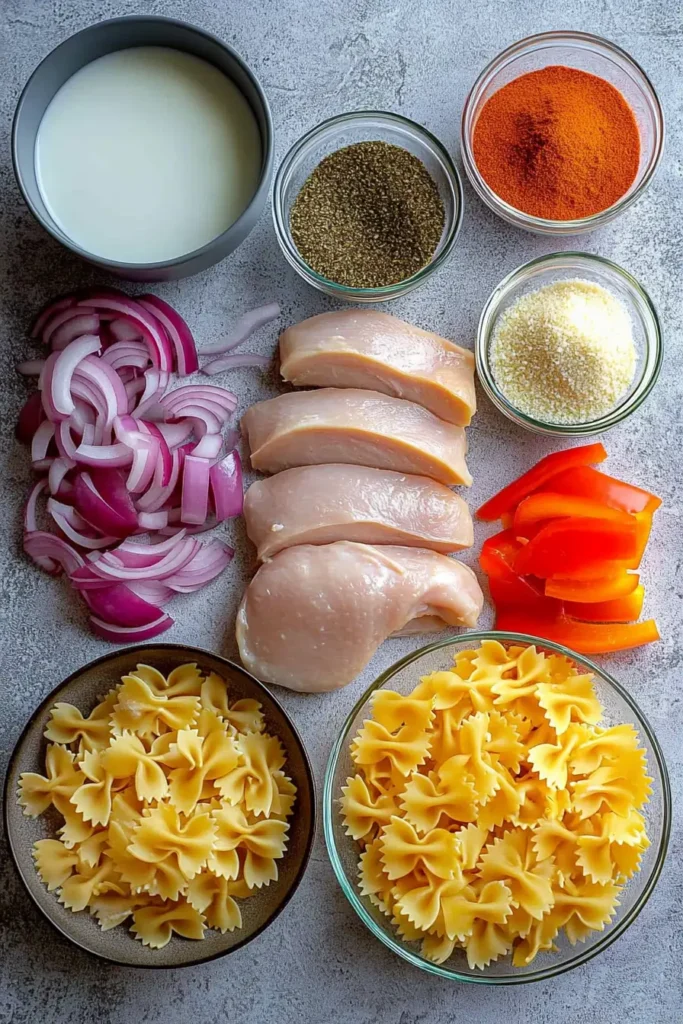
Best pasta types for holding creamy sauces
The type of pasta you use in chicken fajita pasta can make a big difference in texture and taste. Short pastas work best, especially those with ridges or curves that catch and hold sauce. Penne, rotini, and rigatoni are all great options. Their shapes grip onto the creamy fajita sauce, making sure every bite is packed with flavor.
Elbow macaroni also works if you’re looking for a slightly softer bite, especially for kids. If you want a little more chew, try cavatappi. Avoid long pastas like spaghetti or fettuccine for this dish—they don’t hold the ingredients together well and the sauce tends to slide off.
Here’s a quick reference table for pasta choices:
| Pasta Type | Why It Works |
|---|---|
| Penne | Holds sauce well, classic shape |
| Rotini | Spiral shape traps every bit of flavor |
| Cavatappi | Hearty and springy, holds creamy sauces well |
How pasta shape affects texture and flavor blending
Texture matters in creamy dishes like chicken fajita pasta. You want a pasta that can stand up to tender strips of chicken and the soft sautéed peppers and onions without getting lost. Firmer pasta provides contrast, while ridged shapes help distribute seasoning throughout the bowl.
Pasta shape also affects how each forkful feels. With curved or ridged pasta, you get sauce, protein, and veggie in every bite. That makes the dish feel complete without needing extra effort during prep. In one-pan meals, these details help turn basic ingredients into something craveable.
How Long Does Fajita Chicken Last in the Fridge?
Storing cooked chicken fajitas safely
Proper storage is essential to keep your chicken fajita pasta both safe and delicious. Cooked chicken, including seasoned fajita-style chicken, should be cooled and refrigerated within two hours of cooking. Always use airtight containers or resealable bags to prevent moisture loss and reduce exposure to bacteria.
In the fridge, chicken fajita pasta stays fresh for up to 3–4 days. If you’re storing just the cooked chicken separately before assembling the pasta later, it follows the same rule—3–4 days max in a sealed container at 40°F or below. Always place it on the middle shelf for consistent cooling.
For longer storage, chicken fajita pasta can be frozen. Use freezer-safe containers and label them clearly. It holds up well in the freezer for up to 2 months. When reheating, thaw overnight in the fridge and reheat on the stove or microwave until steaming hot throughout.
Signs your chicken fajita leftovers are no longer safe
Even within the safe storage window, you should always check your leftovers before reheating. Look for these signs:
- A sour or off smell
- Slimy texture on the chicken
- Color changes, especially grayish or green spots
- Mold growth
If you notice any of these, it’s best to toss it. No dish is worth the risk of foodborne illness. Reheating leftovers to 165°F ensures safety, but it won’t fix spoiled food. Trust your senses—if it doesn’t smell right, it isn’t right.
Discover quick and flavorful Thin Sliced Chicken Breast Recipes—perfect for busy weeknights!
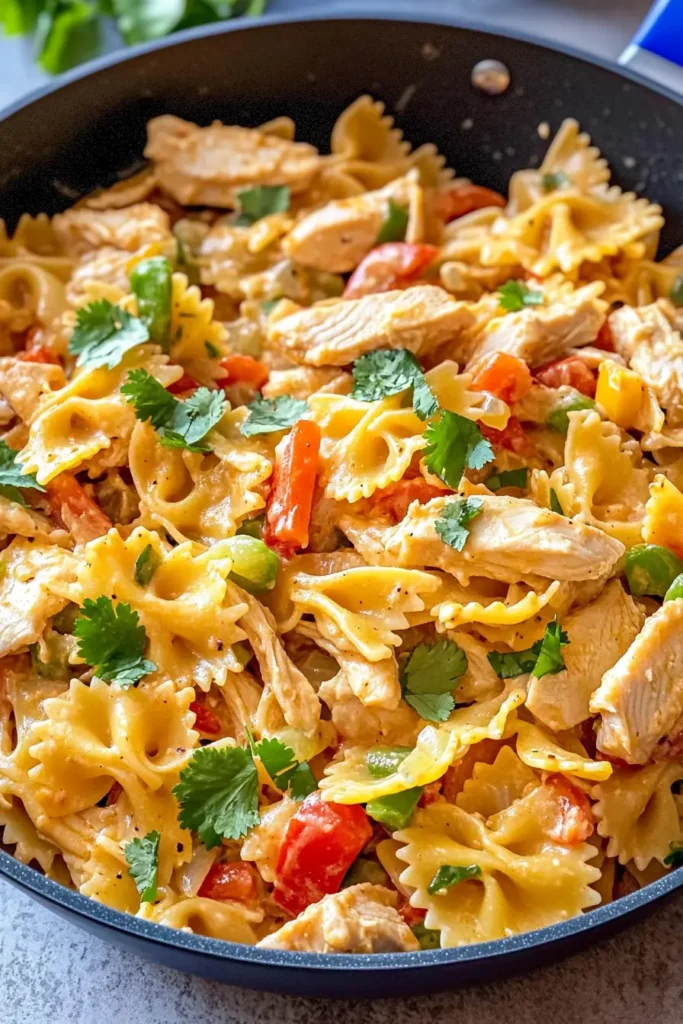
Are Chicken Fajitas Actually Healthy?
Nutritional benefits of lean chicken breast
One of the reasons chicken fajita pasta fits into a balanced diet is its protein-rich foundation. Chicken breast is naturally lean, low in saturated fat, and packed with essential nutrients like niacin, vitamin B6, phosphorus, and selenium. It’s a satisfying protein choice that helps support muscle repair and keeps you feeling full longer.
When prepared with minimal oil and combined with colorful bell peppers, onions, and whole wheat or high-fiber pasta, this dish delivers a well-rounded macro profile. Peppers add a good dose of vitamin C and antioxidants, while onions provide anti-inflammatory compounds. It’s a complete meal that hits your protein, carb, and veggie goals in one bowl.
Healthier cooking swaps for fajita pasta
Traditional chicken fajita pasta often includes heavy cream, cheese, or butter. But you can make smart swaps without losing flavor. Here are some easy, healthier alternatives:
- Use Greek yogurt instead of sour cream or cream cheese for a tangy, protein-rich sauce base.
- Swap white pasta with whole grain, lentil, or chickpea pasta for extra fiber and lower glycemic impact.
- Sauté with olive oil instead of butter for heart-healthy fats.
- Reduce cheese or choose a sharp variety so you can use less but still enjoy the flavor.
Want to keep it low-carb? Skip the pasta altogether and serve the fajita mixture over zucchini noodles or spaghetti squash. These tweaks keep your favorite comfort food on the table, but with benefits your body will thank you for.
How Are Fajitas Traditionally Served?
From sizzling skillets to pasta bowls
Fajitas are known for their iconic presentation: hot, sizzling skillets filled with strips of meat, onions, and bell peppers. At restaurants, they’re usually brought to the table still steaming, often with a side of warm flour tortillas, guacamole, salsa, sour cream, and shredded cheese. Diners then build their own wraps, combining flavors and textures just the way they like.
At home, fajitas are often served in a more casual style—straight from the pan or cast iron skillet with tortillas on the side. The signature ingredients stay the same: seasoned meat (often chicken, beef, or shrimp), seared peppers and onions, and bold, zesty seasoning. This traditional setup invites customization and sharing.
That same flavor base transitions easily into chicken fajita pasta. Instead of tortillas, the seasoned mix is tossed with pasta and a creamy or cheesy sauce. It keeps all the essentials—meat, vegetables, and spice—just in a form that’s perfect for one-pot meals and leftovers.
What toppings and sides pair well with chicken fajita pasta
Just like classic fajitas, the right toppings make chicken fajita pasta pop. Try these add-ons to finish your dish:
- Fresh cilantro for a burst of herby flavor
- Sliced jalapeños for extra heat
- A squeeze of lime to balance the richness
- Diced avocado or a spoon of guacamole for creaminess
- Crumbled queso fresco or shredded cheddar for a cheesy finish
As for sides, this dish is hearty enough to stand alone. But a crisp side salad, warm cornbread, or grilled corn adds contrast and freshness. Chips and salsa or a light black bean salad also fit the Tex-Mex theme.
Creative Twists on Classic Chicken Fajita Pasta
One-pot, baked, and slow-cooker variations
Chicken fajita pasta is versatile, which means you can switch up the cooking method to fit your schedule or tools. One-pot recipes are a favorite for weeknights. You cook everything—from searing the chicken to simmering the pasta—in one pan, cutting down cleanup and keeping all the flavor in one place.
Want to take it further? Try a baked version. After cooking the chicken and pasta, transfer everything to a baking dish, top with cheese, and broil for a golden, bubbly crust. This version works great for feeding a crowd or prepping meals in advance.
For hands-off cooking, go with a slow cooker or Instant Pot version. Add raw chicken, spices, peppers, onions, broth, and uncooked pasta. Let it cook until tender, then stir in cheese or Greek yogurt at the end. These set-it-and-forget-it options are perfect for busy days when you still want a homemade dinner.
Spicy, cheesy, and low-carb versions
Chicken fajita pasta adapts easily to your flavor preferences or diet needs. Love heat? Use poblano peppers or double the chili powder. Craving cheese? Stir in shredded cheddar, Monterey Jack, or pepper jack for a creamy, gooey finish.
Trying to stay low-carb? Swap the pasta for alternatives like spiralized zucchini, spaghetti squash, or shirataki noodles. You can also use cauliflower rice for a fajita bowl vibe with the same bold flavors.
Here’s a quick guide to popular variations:
| Variation | Main Feature |
|---|---|
| Spicy Fajita Pasta | Extra jalapeños, chipotle powder |
| Cheesy Bake | Topped with shredded cheese and baked |
| Low-Carb Option | Uses zoodles, squash, or cauliflower rice |
How to Master Chicken Fajita Pasta Every Time
Timing the pasta and chicken right
The key to the perfect chicken fajita pasta lies in smart timing. Overcooking the chicken makes it dry, and overcooking the pasta makes it mushy—two things that can ruin an otherwise great dish.
Start by searing the chicken in a hot skillet with oil. Cook just until golden on the outside and no longer pink in the center—usually 4–6 minutes depending on thickness. Set it aside to rest while you sauté your peppers and onions in the same pan to soak up that flavor.
Next, cook your pasta al dente—firm to the bite—since it’ll simmer a bit more in the sauce later. If you’re using a one-pot recipe, add pasta to the pan with broth or water and cook it down until tender. This method infuses every bite with spice from the start.
Once everything’s done, bring it all together in the skillet. Add your cream, yogurt, cheese, or chosen sauce base, and mix everything on low heat for a few minutes until well blended and warm.
Final touches that bring out restaurant-quality flavor
Little details make a big difference. Finish your dish with:
- Fresh lime juice – Cuts through the richness of the sauce.
- Chopped cilantro – Adds a fresh, herby contrast.
- A sprinkle of smoked paprika or chili flakes – Gives a final kick of heat and depth.
- Shredded cheese on top – Let it melt into the dish right before serving.
You can even let the whole thing rest for 2–3 minutes after turning off the heat. This allows the flavors to settle and thicken the sauce naturally—no cornstarch or flour needed. Serve hot, and you’ll have a dish that tastes like it came from a restaurant kitchen.
Discover a variety of hearty and flavorful kielbasa and pasta recipes to elevate your mealtime!
Frequently Asked Questions
What culture is chicken fajitas?
Chicken fajitas come from Tex-Mex cuisine—a blend of Mexican and Texan food traditions. The original version used skirt steak, developed by Mexican ranch workers in Texas. Over time, chicken became a popular substitute. While not traditionally Mexican, fajitas reflect the flavors and ingredients common to both cultures, especially grilled meat, peppers, and onions.
How long does fajita chicken last?
Cooked chicken used in fajitas lasts 3 to 4 days in the refrigerator when stored properly in an airtight container. If you need to keep it longer, you can freeze it for up to 2 months. Always check for sour smells, slimy texture, or discoloration before reheating leftovers.
How are fajitas traditionally served?
Traditionally, fajitas are served on a sizzling cast iron skillet with grilled onions, bell peppers, and seasoned meat. Accompaniments often include warm tortillas, guacamole, sour cream, salsa, and shredded cheese. The dish is interactive—each person builds their own fajita wrap to taste.
Why are chicken fajitas healthy?
Chicken fajitas are healthy because they include lean protein from chicken breast and plenty of vegetables like bell peppers and onions. When grilled and prepared with minimal oil or creamy toppings, the dish is low in saturated fat and rich in vitamins, fiber, and antioxidants.
Conclusion
Chicken fajita pasta brings together everything you want in a weeknight dinner—quick prep, bold flavor, and satisfying texture. With juicy, spiced chicken, tender pasta, and creamy sauce, it’s a complete meal in one skillet. The Tex-Mex influence adds personality, while the flexible recipe lets you make it your own with toppings, swaps, and creative twists.
Whether you’re feeding a family, cooking for guests, or meal prepping for the week, this dish checks all the boxes. And with the right storage tips and healthy adjustments, you can keep enjoying it without the guilt. One bite, and you’ll see why chicken fajita pasta deserves a spot in your regular rotation.
Hungry for more? Discover mouthwatering recipes—follow butteryrecipes on Pinterest and Facebook!
Print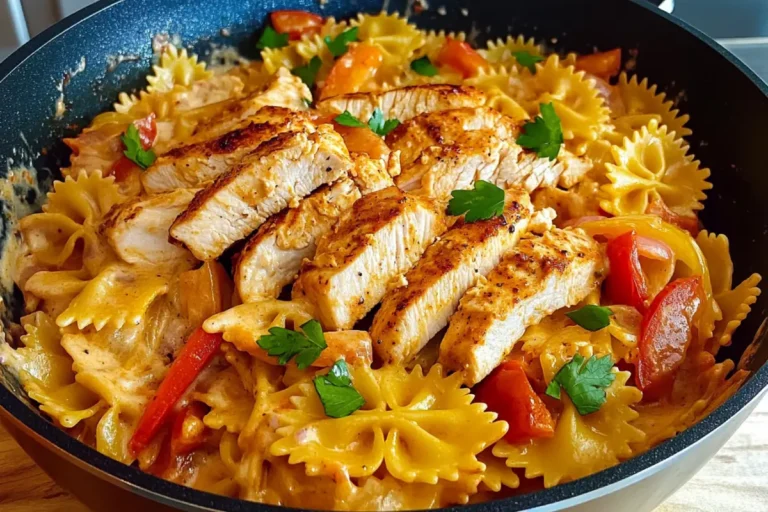
Chicken Fajita Pasta
Chicken Fajita Pasta is a bold, creamy Tex-Mex fusion dish that combines tender chicken, sautéed peppers, and spicy seasoning with rich, comforting pasta. Perfect for weeknight dinners or meal prep, this one-skillet meal is as satisfying as it is flavorful.
- Total Time: 30 minutes
- Yield: 4 servings 1x
Ingredients
- 2 boneless, skinless chicken breasts, sliced
- 1 tablespoon olive oil
- 1 red bell pepper, sliced
- 1 yellow bell pepper, sliced
- 1 green bell pepper, sliced
- 1 onion, sliced
- 2 teaspoons chili powder
- 1 teaspoon paprika
- 1 teaspoon cumin
- 1/2 teaspoon garlic powder
- Salt and pepper to taste
- 8 oz penne or rotini pasta
- 1 cup heavy cream or cream cheese
- 1/2 cup shredded cheddar or Monterey Jack cheese
- Fresh cilantro, for garnish
- Juice of 1 lime
Instructions
- Cook pasta according to package instructions until al dente. Drain and set aside.
- In a large skillet, heat olive oil over medium-high heat. Add sliced chicken and season with chili powder, cumin, paprika, garlic powder, salt, and pepper. Sear until cooked through, about 5–6 minutes. Remove and set aside.
- In the same skillet, sauté bell peppers and onion until tender, about 5 minutes.
- Return chicken to skillet. Stir in cooked pasta, heavy cream (or cream cheese), and shredded cheese. Mix until well combined and heated through.
- Finish with lime juice and chopped fresh cilantro. Serve warm with optional toppings like avocado, extra cheese, or jalapeños.
Notes
For extra flavor, use smoked paprika and add a pinch of oregano. To make it healthier, swap the cream for Greek yogurt and use whole grain or chickpea pasta.
- Prep Time: 10 minutes
- Cook Time: 20 minutes
- Category: Dinner
- Method: Skillet
- Cuisine: Tex-Mex
Nutrition
- Serving Size: 1 bowl
- Calories: 520
- Sugar: 4g
- Sodium: 640mg
- Fat: 27g
- Saturated Fat: 12g
- Unsaturated Fat: 13g
- Trans Fat: 0g
- Carbohydrates: 40g
- Fiber: 4g
- Protein: 32g
- Cholesterol: 95mg
Keywords: chicken fajita pasta, Tex-Mex, creamy pasta, one-pot, weeknight dinner
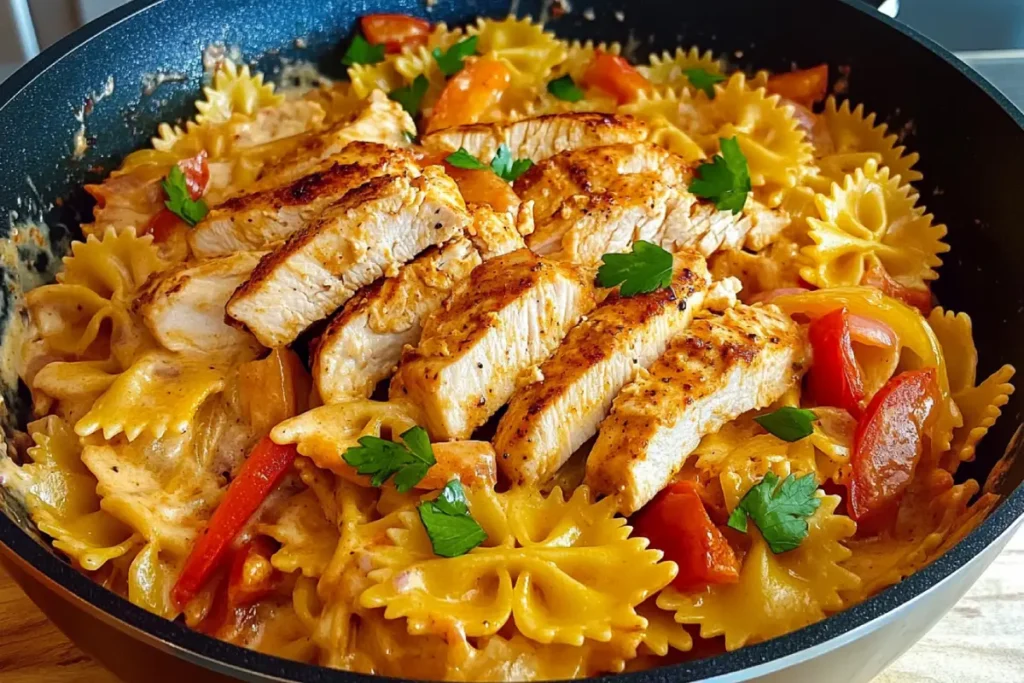
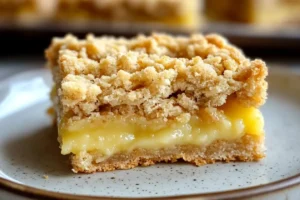
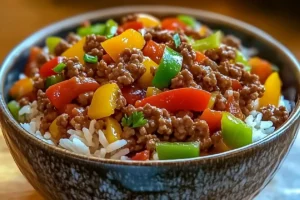
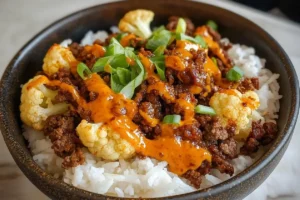
2 thoughts on “Chicken Fajita Pasta: 7 Powerful Twists for Irresistible Flavor”